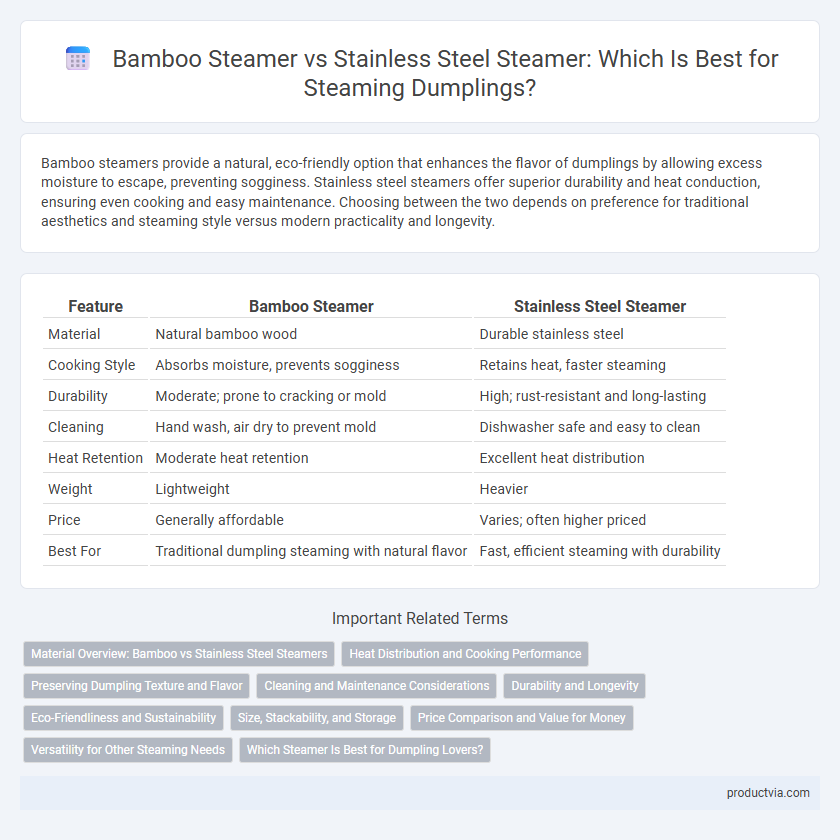Bamboo steamers provide a natural, eco-friendly option that enhances the flavor of dumplings by allowing excess moisture to escape, preventing sogginess. Stainless steel steamers offer superior durability and heat conduction, ensuring even cooking and easy maintenance. Choosing between the two depends on preference for traditional aesthetics and steaming style versus modern practicality and longevity.
Table of Comparison
| Feature | Bamboo Steamer | Stainless Steel Steamer |
|---|---|---|
| Material | Natural bamboo wood | Durable stainless steel |
| Cooking Style | Absorbs moisture, prevents sogginess | Retains heat, faster steaming |
| Durability | Moderate; prone to cracking or mold | High; rust-resistant and long-lasting |
| Cleaning | Hand wash, air dry to prevent mold | Dishwasher safe and easy to clean |
| Heat Retention | Moderate heat retention | Excellent heat distribution |
| Weight | Lightweight | Heavier |
| Price | Generally affordable | Varies; often higher priced |
| Best For | Traditional dumpling steaming with natural flavor | Fast, efficient steaming with durability |
Material Overview: Bamboo vs Stainless Steel Steamers
Bamboo steamers are crafted from natural bamboo, which offers excellent heat absorption and moisture retention, contributing to a softer texture in dumplings. Stainless steel steamers provide durability, resistance to rust, and faster heat conduction, enabling quicker and more uniform cooking. Choosing between bamboo and stainless steel depends on preferences for traditional aesthetics and flavor preservation versus convenience and longevity.
Heat Distribution and Cooking Performance
Bamboo steamers provide gentle, even heat distribution that preserves the delicate texture and moisture of dumplings, preventing overcooking or drying out. Stainless steel steamers heat up quickly and maintain consistent temperature, offering faster cooking times but may cause uneven cooking if overcrowded. The porous nature of bamboo allows steam to circulate effectively, enhancing flavor, while stainless steel's durability supports rigorous use and easy cleaning.
Preserving Dumpling Texture and Flavor
Bamboo steamers excel at preserving dumpling texture and flavor by allowing gentle, even steam circulation that prevents sogginess and maintains moisture balance. Stainless steel steamers heat quickly and are durable but can create condensation that risks making dumplings soggy, impacting their delicate texture. Choosing bamboo steamers ensures an authentic, tender bite with enhanced aroma retention ideal for traditional dumpling preparation.
Cleaning and Maintenance Considerations
Bamboo steamers require gentle handwashing and thorough drying to prevent mold and cracking, making their maintenance more delicate compared to stainless steel steamers. Stainless steel steamers offer easier cleaning through dishwasher compatibility and higher durability, resisting rust and deformation over time. For frequent use with dumplings, stainless steel provides a low-maintenance, long-lasting option, whereas bamboo steamers need careful upkeep to maintain their natural material integrity.
Durability and Longevity
Bamboo steamers offer a traditional design that is biodegradable and naturally resistant to absorbing flavors but can wear out faster due to moisture and frequent use. Stainless steel steamers provide superior durability with resistance to rust, corrosion, and physical damage, ensuring a longer lifespan even under heavy steaming conditions. For dumplings, choosing stainless steel ensures consistent performance and longevity, while bamboo offers a classic aesthetic with moderate durability.
Eco-Friendliness and Sustainability
Bamboo steamers are highly eco-friendly due to their natural, biodegradable materials and low energy production process, making them a sustainable choice for steaming dumplings. Stainless steel steamers, while durable and recyclable, have a higher environmental impact from mining and manufacturing processes but offer long-term reusability and resistance to rust. Choosing between the two depends on valuing biodegradable organic materials versus the longevity and recyclability of metal.
Size, Stackability, and Storage
Bamboo steamers typically come in varying diameters, often around 8 to 12 inches, and feature multiple stackable layers that allow simultaneous cooking of different dumplings, optimizing kitchen space and meal prep time. Stainless steel steamers tend to have adjustable stack heights and often include a collapsible design for easier storage, making them ideal for compact kitchens with limited cabinet space. While bamboo steamers provide a natural aesthetic and allow steam to circulate easily, stainless steel options offer durability and often nest within each other, enhancing storage efficiency without sacrificing cooking capacity.
Price Comparison and Value for Money
Bamboo steamers typically cost less than stainless steel steamers, offering an affordable option for dumpling preparation while providing natural heat absorption and a traditional aesthetic. Stainless steel steamers, though pricier, deliver superior durability, easier maintenance, and even heat distribution, resulting in consistent cooking performance. For value-conscious consumers prioritizing longevity and ease of cleaning, investing in a stainless steel steamer may offer better long-term benefits despite the higher initial price.
Versatility for Other Steaming Needs
Bamboo steamers excel in versatility by allowing gentle, even steaming suitable for delicate foods like dumplings, vegetables, and fish, with their natural material absorbing excess moisture to prevent sogginess. Stainless steel steamers offer superior durability and can be used on various heat sources, making them ideal for steaming a wider range of foods quickly and efficiently. Both types accommodate multiple tier stacking, but bamboo steamers provide a more authentic steaming experience for traditional Asian cuisines.
Which Steamer Is Best for Dumpling Lovers?
Bamboo steamers provide gentle, even heat and allow excess moisture to escape, preserving the delicate texture and flavor of dumplings, making them ideal for traditional dim sum cooking. Stainless steel steamers heat up quickly, are more durable, and easier to clean but can trap moisture, sometimes resulting in soggier dumplings unless carefully monitored. For dumpling lovers seeking authenticity and texture, bamboo steamers are often preferred, while stainless steel offers convenience and longevity.
Bamboo steamer vs Stainless steel steamer for dumplings Infographic

 productvia.com
productvia.com